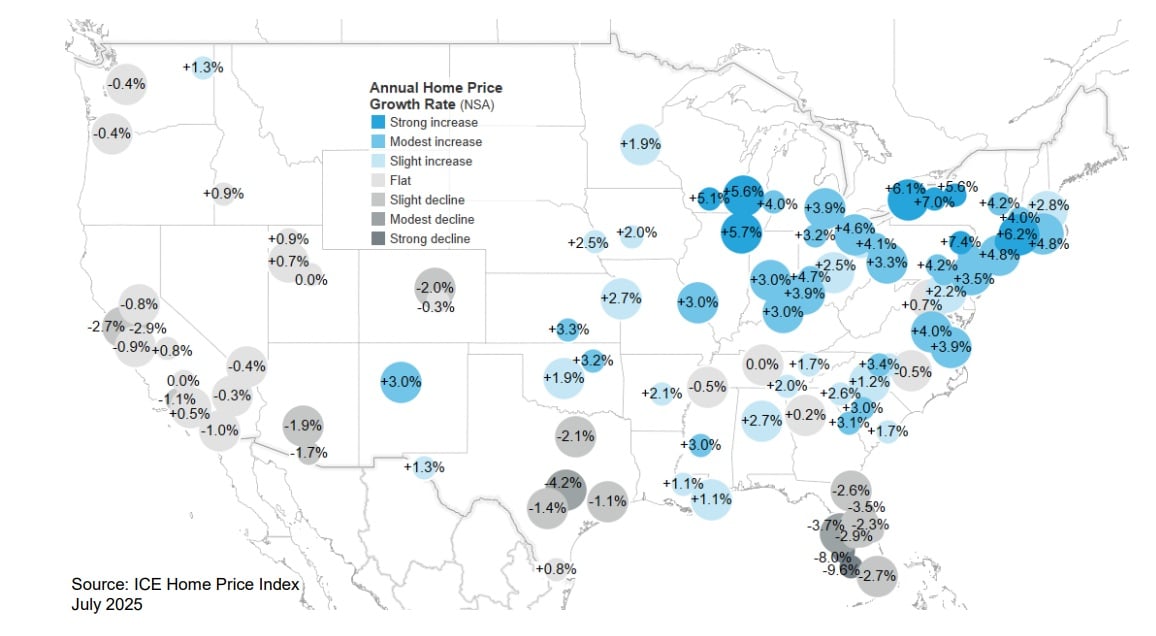Prices are holding up in the Northeast and Midwest, but are down from a year ago in more than 70 percent of Western markets and 40 percent of Southern markets.
New data out Monday shows America remains a tale of two housing markets, with home prices still rising in much of the Northeast and Midwest even as a surge in inventory that’s helped fuel price declines in the Sunbelt spreads to more Western markets.
Home prices have come down from a year ago in more than 70 percent of Western markets, compared to 40 percent of Southern markets — although states like Florida and Texas have seen the sharpest declines, according to data released Aug. 11 by ICE Mortgage Technology.
“Price softening continued to spread from the Sunbelt to the West in July with one-third of major markets now seeing prices down from the same time last year,” the mortgage and software and data company reported.
Cape Coral, Florida posted the largest year-over-year decline in the ICE Home Price Index, at -9.6 percent, followed by North Port (-8.0 percent) and Austin, Texas (-4.2 percent).
Annual home price appreciation by market

Source: ICE Mortgage Monitor, August 2025
“Softer patches continue to emerge in California with nine of the state’s ten largest markets now below last year’s price levels,” ICE reported. “That said, with sellers stepping back and inventory trending lower in some Northern California markets over the past two months, price trends across the state will be worth watching closely.”
Home price appreciation is decelerating in the Midwest and Northeast, but hot markets include Scranton, Pennsylvania (7.4 percent annual home price growth), Rochester, New York (7.0 percent), New Haven (6.5 percent) and Hartford (6.2 percent) Connecticut and Buffalo, New York (6.1 percent).
Looking at home prices relative to post-pandemic peaks, the ICE Home Price Index shows several markets have posted double-digit declines, and that prices are down 3 percent or more in 15 markets in states including California, Idaho, Colorado and Utah.
Markets with biggest price declines from peak
- Austin, Texas (-20.2 percent)
- Cape Coral, Florida (-14.1 percent)
- North Port, Florida (-12.2 percent)
- San Francisco, California (-9.3 percent)
- Phoenix, Arizona (-6.8 percent)
- San Antonio, Texas (-5.3 percent)
- Boise City, Idaho (-5.1 percent)
- Stockton, California (-4.8 percent)
- Deltona, Florida (-4.7 percent)
- Denver, Colorado (-4.5 percent)
- Tampa, Florida (-4.4 percent)
- Lakeland, Florida (-3.8 percent)
- Palm Bay, Florida (-3.4 percent)
- Dallas, Texas (-3.4 percent)
- Provo, Utah (-3.0 percent)
- Jacksonville, Florida (-2.9 percent)
- Sacramento, California (-2.8 percent)
- San Jose, California (-2.8 percent)
- Miami, Florida (-2.8 percent)
- Orlando, Florida (-2.6 percent)
- Portland, Oregon (-2.4 percent)
- Oxnard, California (-2.2 percent)
- Seattle, Washington (-2.2 percent)
- Colorado Springs, Colorado (-2.0 percent)
- Salt Lake City, Utah (-1.7 percent)
- Las Vegas, Nevada (-1.6 percent)
- Tucson, Arizona (-1.6 percent)
- Ogden, Utah (-1.5 percent)
- San Diego, California (-1.4 percent)
- Houston, Texas (-1.1 percent)
- Bakersfield, California (-1.1 percent)
Seasonally adjusted price changes from local market post-pandemic peaks. Source: ICE Mortgage Monitor, August 2025.
More than three quarters of Americans surveyed by Fannie Mae in July (77 percent) said it was a bad time to buy, up from 71 percent in June but down from 82 percent a year ago.
But consumers were slightly more optimistic that mortgage rates will come down over the next 12 months (28 percent) than they were in June (25 percent).
Consumer housing sentiment edged up in July
Fannie Mae’s Home Purchase Sentiment Index, which distills six questions from the mortgage giant’s monthly National Housing Survey, increased by 2 points to 71.8 in July.
The survey of 1,140 household financial decision makers was conducted between July 1 and July 21, with results published on Aug. 8.
Other surveys also show consumer confidence improved in July, but that many would-be homebuyers are still concerned about the prospect that tariffs will lead to higher prices and fewer jobs.
Get Inman’s Mortgage Brief Newsletter delivered right to your inbox. A weekly roundup of all the biggest news in the world of mortgages and closings delivered every Wednesday. Click here to subscribe.
Email Matt Carter
